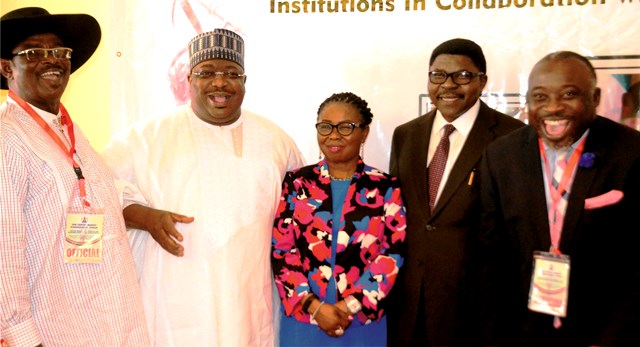Business
‘FG Needs More Borrowing To Fund Infrastructure’

The Federal Government is expected to take more loans if its plan to fund infrastructure is to be realised, says a senior analyst at Agusto & Co, Mr Jimi Ogbobine.
Ogbobine said this at a training for financial journalists during the Finance Correspondents Association of Nigeria’s annual workshop in Lagos yesterday. He said government was expected to deploy about N1.6 trillion to fund infrastructure this year.
He said that the training, entitled, “Analysis of the Macroeconomic Environment’, organised by Rand Merchant Bank, was meant to deepen journalists’ knowledge of the economy and financial industry developments.
Ogbobine said the bulk of financing for infrastructure would come from borrowing with a larger share being domestic debts.
He also said funding the capital budget would require higher than planned borrowing with adverse implications for interest rates and interest costs for the economy.
“The Federal Government borrowing to fund infrastructure is likely to be between N1.2 and N1.6 trillion.
“The implementation is unlikely to start before the second quarter and revenue is likely to be lower than planned.
“Actual funding from asset restructuring, recoveries and others may be substantially lower than the planned level of N2 trillion.
“Therefore, fully funding the capital budget will mean higher than planned borrowing with adverse implications for interest rates and interest costs,” he said. He added that obligatory spending of the federal government was still more than 100 per cent of revenues, hence, there was no free cash flow for investment in infrastructure.
“Every kobo of infrastructure spending is financed by debt constraints ability to fully fund budgeted amounts.
“Debt as percentage of revenue is significantly higher than the median, of 200 per cent, for countries in Middle East & Africa.
“Federal Government plans to partly finance 2018 capital expenditure with proceeds of asset sales,” he said. Speaking on inflation, he said a hyper-inflationary environment was one where prices double at least every three years.
“This means inflation rate of about 25 per cent per annum.
“In such environments, investors hold savings in low inflation currencies like dollars, Pounds Sterling and Euros.
“Also, business persons price products, particularly those with a high import content in these low inflation currencies, usually the dollar.
“In effect, such environments are ‘dual currency environments’.
“Real Gross Domestic Product per capita should grow in 2018, making it easier for businessmen to access forex to fund their operations. Therefore, most businesses should see top line and profit growths while unemployment rate will fall but the level will remain high,” he said.
The analyst said actual deficit might be lower than planned deficit largely because of a low implementation of the capital budget.
Ogbobine said that based on the long-term inflation difference, the naira-dollar exchange rate should close 2018 at about N420/1 in the Investors & Exporters’ FX Window.
He, however, predicted that should oil revenues increase, the CBN might try to keep rates in the market as close as possible to the current levels.
Business
NCAA Certifies Elin Group Aircraft Maintenance

Business
SMEDAN, CAC Move To Ease Business Registration, Target 250,000 MSMEs

Business
Blue Economy: Minister Seeks Lifeline In Blue Bond Amid Budget Squeeze

Ministry of Marine and Blue Economy is seeking new funding to implement its ambitious 10-year policy, with officials acknowledging that public funding is insufficient for the scale of transformation envisioned.
Adegboyega Oyetola, said finance is the “lever that will attract long-term and progressive capital critical” and determine whether the ministry’s goals take off.
“Resources we currently receive from the national budget are grossly inadequate compared to the enormous responsibility before the ministry and sector,” he warned.
He described public funding not as charity but as “seed capital” that would unlock private investment adding that without it, Nigeria risks falling behind its neighbours while billions of naira continue to leak abroad through freight payments on foreign vessels.
He said “We have N24.6 trillion in pension assets, with 5 percent set aside for sustainability, including blue and green bonds,” he told stakeholders. “Each time green bonds have been issued, they have been oversubscribed. The money is there. The question is, how do you then get this money?”
The NGX reckons that once incorporated into the national budget, the Debt Management Office could issue the bonds, attracting both domestic pension funds and international investors.
Yet even as officials push for creative financing, Oloruntola stressed that the first step remains legislative.
“Even the most innovative financial tools and private investments require a solid public funding base to thrive.
It would be noted that with government funding inadequate, the ministry and capital market operators see bonds as alternative financing.
-

 Sports23 hours ago
Sports23 hours agoFalconets thrashes 4-0 Rwanda in qualifiers
-

 Education22 hours ago
Education22 hours agoFRSC to Establish Driving Training Centre at UniPort
-

 Oil & Energy22 hours ago
Oil & Energy22 hours agoAfam 2 Power Plant Adds 160MW To National Grid, says Sahara Group
-

 Business22 hours ago
Business22 hours agoSMEDAN, CAC Move To Ease Business Registration, Target 250,000 MSMEs
-

 Maritime23 hours ago
Maritime23 hours agoBlue Economy: FG Targets Lower Logistic Costs, Trade Competitiveness
-

 Rivers22 hours ago
Rivers22 hours agoYouth Leader Lauds Tinubu, Over Ogoni oil Dispute
-

 News22 hours ago
News22 hours agoShettima departs New York for Germany after UNGA engagement
-

 Sports23 hours ago
Sports23 hours agoFBN, Group Hold First E1 Lagos GP Champion Oct.3

